IDEX Online Research: Untangling Zale’s Fiscal Year-End Results
September 06, 07
Were you able to figure out what Zale’s revenues and profits were for the fiscal year ended July 2007? Management just reported financial results, and thanks to Sarbanes-Oxley and a bunch of accountants at the Financial Accounting Standards Board, you would need a CPA and a CFA designation to untangle the results.
Don’t blame Zale. They are meeting the letter of the law. Blame the concept of transparency. We agree with transparency, but it has made it more difficult for the unskilled investor to understand what’s happening.
Full Year Results
If you guessed that Zale’s full year revenues were flat at about $2.4 billion, you’d be in the ballpark. But, the fact is that revenues were actually up slightly for the most recent year. Due to a change in accounting relating to revenue recognition for Zale’s Lifetime Jewelry Protection Plan, the company was forced by accounting standards to defer a significant level of revenue (about $111 million) over a five-year period. (It is actually much more complex than that, so please just take our word for it.)
If you guessed that Zale’s earnings improved in 2007, you might want to re-think your position. In its news release, it stated 2007 earnings as $59.3 million versus the prior year’s $53.6 million. But if you remove one-time unusual expenses and costs, “apples-to-apples” earnings were $74.4 million in 2007, down from the prior year’s $90.9 million.
Zale included tables with this reconciliation along with its news release, but they could be deciphered only by the financially literate. Is it fair to remove unusual costs? They are part of doing business and should be recognized, in our opinion, but year-to-year earnings comparisons cannot be made on an equitable basis.
Here’s our analysis and summary of the earnings comparisons for Zale.
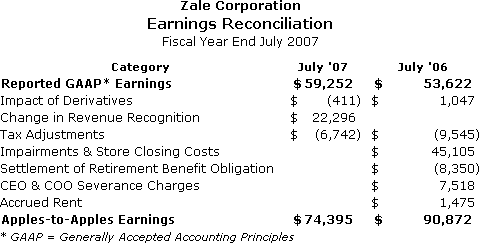 Source: Zale Corporation |
Highlights from Financial Results & Management Discussions
Highlights from Zale’s fiscal year end conference call include the following:
- For the year, same-store sales were down 0.2 percent; total reported revenues were about flat at $2.44 billion. The following table summarizes same-store sales performance by brand for the year.
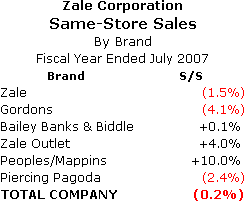 Source: Zale Corporation |
- Zale will begin including online sales in its same-store sales report. Beginning in the current fiscal year, Zale will include online jewelry sales in its reported same-store sales results. Unfortunately, management would not disclose its online sales volume for the fiscal year ended July 2007. For the prior year, we estimate that they were about $25 million, and it would not be unreasonable to assume that they were between $35-40 million for the just-completed fiscal year; that’s about 1.4 percent of sales. The table below compares Zale’s reported same-store sales for the 2007 fiscal year with and without online sales.
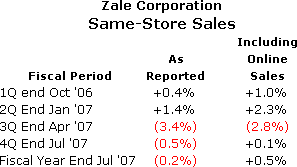 Source: Zale Corporation |
- Strong and weak merchandise categories in the fourth fiscal quarter (May, June, July 2007) include the following:
- Fashion jewelry was strong in Gordon’s, but weaker at Zale’s.
- Diamond fashion jewelry was strong across all brands.
- All categories were strong at the Zale’s Outlet stores.
- Watch sales were up double digit levels at Bailey Banks & Biddle.
- Semi-precious gemstone jewelry showed double digit gains.
- Diamond jewelry sales were up double digit levels.
- Gold chain demand waned at Piercing Pagoda, but diamond fashion jewelry and body jewelry were strong categories.
- Business post-Mother’s Day strengthened.
- The average ticket by brand was mostly up in the July quarter, as shown on the following table. The average ticket at Bailey Banks & Biddle dropped due to a special promotion during the quarter; we consider this an anomaly.
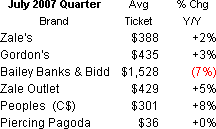 Source: Zale Corporation |
- The company is in the midst of a major effort to centralize operations. Among its mass market brands, it has eliminated its brand presidents. Management made the following comments about the centralization effort.
- Zale mass market brands (Zale’s, Gordon’s, Zale’s Outlet, Peoples, Mappins) will now function as a team; the competition between each brand is basically being eliminated.
- There are two management operating teams in the centralized organization.
- Merchandising – This team will be responsible for brand assortment and determining what the customer wants.
- Sourcing – This team will buy – at the best price – what the merchandising team tells them to buy. Zale buyers will no longer buy a deal just because the price is right; it must fit the merchandising plan.
-
- Eventually, Zale will be organized by its “mall brands” and “all other.” The Zale’s Outlets brand is not considered to be a mall brand for a variety of reasons.
- Eventually, 80-90 percent of Gordon’s and Zale’s SKUs (merchandise items) will be identical at both brands. Last year, about 20 percent of the items were the same in the holiday selling season; this will rise to about 40 percent this year.
- Zale will differentiate its Zale’s and Gordon’s brands by advertising. While the merchandise in the two brands will be nearly identical, the advertised items will be different, according to management. In addition, the store experience will be somewhat different, according to management, though no details were provided.
- There will be minimal cost reductions initially flowing from the centralization effort. There have been no massive layoffs – nor are there any plans for major layoffs – resulting from the centralization initiative.
- Store openings will slow. Up to 37 new stores could be opened (mostly Zale Outlet and Peoples); this represents a 2.5 percent increase in total store units. Up to 10 kiosks may be opened; this would be an increase of 1.3 percent. Management plans to focus new store openings in its Zale’s Outlet brand and its two Canadian brands, Peoples and Mappins. In particular, the opportunity for Mappins could include up to 100 new stores in the future.
- It is likely that Zale will close a group of stores in early 2008. While management was non-committal, it said that a group of stores has been identified that may be closed. We believe that there could be a meaningful number of stores in this group, but we are unable to quantify the exact number. In the fourth quarter (ended July 2007), the company closed 32 Peoples II carts as it exited this business.
The number of stores by brand for the past three years is shown on the table below.
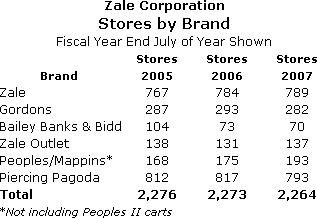
Source: Zale Corporation
- Gordon’s will not become a second national brand for Zale Corporation. Management said Gordon’s does not have the potential to roll out on a national scale. Further, its return on invested capital is not high enough.
- Management said that Piercing Pagoda, while roughly stagnant in terms of sales and units, provides strong cash flow and a solid return on invested capital. When asked if Piercing Pagoda might be divested, management had no comment.
- Bailey Banks & Biddle is a big question mark. It now consists of only 70 units, down from a peak of 124 in 2001. Its management is still intact, and it is apparently not involved in the current centralization effort. Management was strangely silent about Bailey Banks & Biddle, and did not mention it, other than in passing, during its discussion with Wall Street analysts. When asked if it might be sold, management would not comment. We believe that Bailey Banks & Biddle would fetch a high price, if it were sold. However, its same-store sales were essentially flat for the year; most other guild jewelers posted robust sales gains.
- Management noted that its inventory levels were too high, and said that it planned to reduce inventory by at least $50 million over the next year. It also said that “Accounts Payable” would rise. When asked if this meant that management would be leaning on vendors for longer payment terms, management said “no.” Because the company has not been replenishing recently, its vendor payables had declined as it paid vendor invoices. While overall inventory levels will decline, management plans to resume ordering goods, and payables will rise in the ordinary course of events.
Zale Corporation’s annual inventory turn declined modestly to 1.09x versus 1.26x in the most recent fiscal year.
Management noted that it still has about $30 million of clearance merchandise left from the prior fiscal year. This will be sold off over the next 12-18 months. Thus, we expect a total inventory decline of near $80 million ($50 million reduction in goods plus $30 million sell-off of clearance merchandise), less any inventory increase associated with new stores.
- Zale management spent much time explaining its Lifetime Jewelry Protection Plan (LJPP) because this new plan has had a detrimental impact on reported financials. Essentially, Zale’s accountants are making the company recognize the revenue from the LJPP over a five-year period. This five-year period has been defined as the “lifetime” of the protection plan; essentially, Zale has determined that virtually all claims which will be made under this plan will likely occur within five years of purchase of the merchandise. In the fiscal year ended July 2007, Zale generated $111 million of LJPP revenue, versus $78 million. The attachment rate has risen to 50 percent from 42 percent last year. By 2011, deferred LJPP revenues will be flowing through the company’s income statement at roughly the same rate as cash revenues, and LJPP revenues will not be a notable factor affecting reported revenues versus deferred revenues. Most of the discussion of LJPP revenues related to helping Wall Street analysts understand the financial accounting related to this program.
- While the customer in Zale’s and Gordon’s is similar, the customer who shops Zale’s Outlet is different. In broad terms, the Zale’s Outlet customer is more likely to be an affluent female self-purchaser. Thus, Zale’s Outlet will focus its inventory assortment on meeting the needs and wants of that customer. The average ticket for Zale’s Outlet is $429, or nearly 11 percent greater than the average ticket for a traditional mall-based Zale’s store. Further, the average ticket in Zale’s Outlet rose by 5.1 percent in fiscal 2007, versus a 2.3 percent increase in the average ticket at a Zale’s mall store.
Zale management says that Zale’s and Zale’s Outlets do not cannibalize each other. Not only is the customer different, but they are remote from each other. Zale’s stores are in malls; Zale’s Outlet units are free-standing non-mall locations.
- Direct sourcing is a major strategic initiative for the company. In the most recent fiscal year, about 35 percent of the company’s goods were direct-sourced, up from 27 percent in the prior fiscal year. Zale assembled about 8.5 percent (by value) of its goods during the year, up from 4.4 percent in the prior year. Long term, at least 50 percent of Zale’s merchandise will be direct-sourced from jewelry producers.
- When management was questioned about why it did not combine with Sterling Jewelers last year, it gave two reasons:
- The complex structure of the two companies does not lend itself to a merger.
- The return to shareholders would not have been sufficient.
- Zale’s holiday sales plans are mostly similar to last year, according to management.
- Zale’s will be less aggressively priced this year, especially with its Brilliant Buys merchandise. Because it was aggressively priced last year, gross margins suffered. Management is focusing much more on gross margin management this year.
- Zale’s and Gordon’s will coordinate promotional schedules this year. Because 40 percent of their merchandise will be identical, they will differentiate themselves with their advertising, particularly on television.
- Pricing between brands will be much more unified.
- The overall promotional strategy will be unchanged. Advertising will be similar to last year
- Zale will feature Journey diamond jewelry; this has been a hot category.
- There is no dramatic new product in the industry this year, so Zale will promote what sold last year.
-